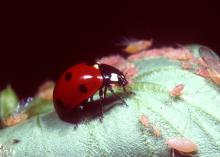
Biodiversity Controls Ecological 'Services,' Report Scientists in Comprehensive Analysis
Accelerating rates of species extinction pose problems for humanity, according to a comprehensive study headed by a biologist at the University of California, Santa Barbara and published in the journal Nature this week.
The groundbreaking statistical analysis demonstrates that the preservation of biodiversity -- both the number and type of species -- is needed to maintain ecological balance and "services." The concern about losing numbers of species versus types of species has been an area of scientific controversy for over a decade.
"By combining the results of more than a hundred studies performed over two decades, we were able to conclusively show that the extinction of species from our planet will change the way pests and diseases are controlled, organic wastes are broken down and recycled, food is produced by ecosystems, and water is purified," said Bradley J. Cardinale, first author and associate professor in the Department of Ecology, Evolution and Marine Biology at UCSB.
The 111 field, greenhouse, and laboratory studies that were analyzed by the authors came from experiments performed on species from around the world.
"Until recently, scientists knew a lot about the causes of extinctions, but surprisingly little about their consequences," said Diane S. Srivastava, second author and professor in the Department of Zoology at the University of British Columbia.
Cardinale explained that one-third to one-half of all the species on the planet are expected to be lost in the next 100 years, and that currently species are going extinct at thousands of times faster than they have historically. The losses are due to the cutting down of rainforests, development, pollution, and the introduction of exotic species that take over the niches of indigenous species.
"Our study shows that biodiversity matters," said Srivastava. "Ecosystems with more species function better, that is, they are more efficient in moving energy and matter. In practical terms, this means that diverse ecosystems are better at, for example, controlling pests, breaking down organic matter, and absorbing carbon dioxide, a greenhouse gas."
As one example, one of the 111 studies included in the analysis reveals the role of species diversity in controlling agricultural pests. That experiment shows the critical importance of the ladybug beetle -- part of a synergistic "team" of three aphid predators. In this study, Cardinale presented evidence that together, a specific group of predators (the ladybug, the damsel bug, and the parasitic wasp), can reduce the density of aphids, in turn increasing the yield of alfalfa, an economically important crop. His study was performed in Wisconsin and showed that all three natural enemies together reduce the aphids to a greater extent than is predicted from each natural enemy alone. He explained that this service, provided by species diversity, is worth millions of dollars for agriculture in Wisconsin alone, not including the fact that the farmers do not have to spray their alfalfa crops when the three key predator species abound.
Cardinale said, "We now have good evidence that the number and type of species on the planet regulate services that affect humanity. If we value these services, then we need to protect biodiversity."
He explained that it is important to set aside protected areas. For example, marine protected areas, national parks, and ecological reserves can all help to preserve biodiversity. Additionally it is important to consider biological "hot spots," where biodiversity is high. "We could save a lot of species with only small areas, by putting aside hot spots," he said.
Cardinale's varied research interests are tied together by a common thread, which is to understand the causes and consequences of changing biodiversity in the modern era.
The study published in Nature was supported by grants from the National Science Foundation.
Related Links



